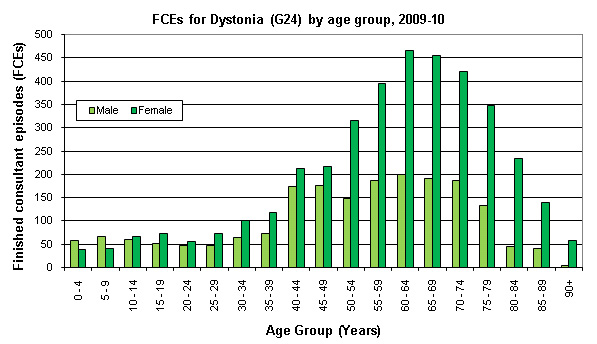IN THIS SITE...

- NHS Choices: Dystonia
- Inpatient data
- Self service
HES on... Dystonia
What is dystonia?
Dystonia is a range of movement disorders which cause involuntary muscle spasms and contractions. The spasms and contractions that are associated with dystonia can cause the affected body parts to make repetitive movements and take on unusual and awkward postures.
Dystonia is thought to be a neurological condition, that is a condition that is caused by underlying problems with the nervous system and brain. However, in most cases, other functions of the brain, such as intelligence, memory and language are unaffected.
Who does it affect?
While dystonia is generally an uncommon condition, it is however one of the most common neurological conditions. NHS Choices estimates that 38,000 people in the UK are affected by dystonia in each year.
Dystonia can affect people of all ages, including children. However, symptoms most commonly begin when a person is between 40 and 60 years old.
 |
Footnotes:
1. Finished Consultant Episode (FCE): A finished consultant episode (FCE) is a continuous period of admitted patient care under one consultant within one healthcare provider. FCEs are counted against the year in which they end. Figures do not represent the number of different patients, as a person may have more than one episode of care within the same stay in hospital or in different stays in the same year.
2. Finished admission episodes: A finished admission episode (FAE) is the first period of inpatient care under one consultant within one healthcare provider. FAEs are counted against the year in which the admission episode finishes. Admissions do not represent the number of inpatients, as a person may have more than one admission within the year.
3. Main procedure or intervention: The first recorded procedure or intervention in each episode, usually the most resource intensive procedure or intervention performed during the episode. It is appropriate to use main procedure when looking at admission details, (e.g. time waited), but a more complete count of episodes with a particular procedure is obtained by looking at the main and the secondary procedures.
More information on this topic is available from NHS Choices here.

